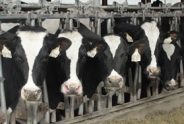Record Silking/Tasseling Dates for Corn Fields
Contributed by Joe Lawrence, Cornell PRO-DAIRY; original article can be found here at https://blogs.cornell.edu/ccef...
Tracking Growing Degree Days (GDD's) is an effective way to monitor the progress of a corn crop and in recent years a number of online tools for tracking GDD's have been developed. For the Northeast, the Climate Smart Farming GDD tool from Cornell is a great option. Dr. Kitty O'Neil with the North Country Regional Ag Team prepared an instructional video for using the tool. While this tool was designed to estimate GDD accumulation from planting, you can simply enter in silking/tasseling date in the planting date box to track accumulation from that date.
One approach to predicting corn maturity with GDD's is to monitor GDD's from planting to harvest and some seed brands provide estimates of GDD's needed for different hybrids. For corn, the 86/50 method is used for calculating GDD's, this references a base temperature of 50oF and a maximum of 86oF.
There are few considerations to keep in mind for this;
- The numbers provided for a hybrid are often from planting to physiological maturity (black layer) which is past the silage stage. A rough rule of thumb is to subtract 150 GDD's from this number to estimate the number needed for silage harvest.
- Studies have shown a fair amount of variation in the GDD's required from planting to silking, which could be exacerbated by the variable weather conditions experienced so far in 2022.
Research in NY by Dr. Bill Cox assessed the number of GDD's required from silking to silage harvest timing in a multi-year study. While there is still some variability in GDD requirements from silking to silage harvest timing, this method offers better results than using full season numbers as it takes out the early season variability of GDD's needed from planting to silking. The average GDD's reported in the study are shown in Table 1.
This study used 32 percent whole plant dry matter (DM) as the target for silage harvest; however, a better target is 35 percent whole plant DM. Therefore, the GDD targets reported in the study offers a sort of early warning for harvest. Once corn begins the dry down process an average rate of dry down is 0.5 percent per day (with a range of zero to one percent per day) indicating that the crop may reach 35 percent DM approximately 6 days after reaching these GDD targets for 32 percent DM.
When a field reaches these GDD targets, it is a good time sample fields and dry down samples for whole plant DM to further refine harvest timing.
Upcoming Events
Memoir Reading: Barn Gothic
December 4, 2025
Bath, NY
Barn Gothic is an elegy for family farmers and an intimate portrait of three generations laboring to be fathers and sons while their livelihood falls apart. Beautifully told with a farmer's restraint and a poet's grace, it is a story of personal loss amid corporate corruption and of finding a way forward when everything you know disappears.
NY Small Farms Summit 2025: Stronger Together
December 5, 2025
Alfred, NY
We hope you will join us on December 5th for the 2025 New York Small Farms Summit! This is an opportunity to meet other farmers and ag supporters, learn about research and education projects, and set priorities for future efforts to grow small farm success.
At the Allegany County site, we will focus on giving trees a chance and how trees build resiliency on small farms. Whether attracted to fruit, nuts, vegetables, fodder or shade, trees can be an integral part of a successful farming system. Join us as we explore the opportunities for resiliency that come from adding tree crops or managing wooded areas of your farm for agroforestry or silvopasture systems.
Crops, Cows & Critters - Southwest New York Dairy, Livestock & Field Crops Newsletter Sponsorship
December 19, 2025
Our two forms of publications feature research-based and timely information from our four specialists, listed to the right, along with local event notifications and Cornell University outreach. This information is provided to participants who range from dairy, livestock, and field crops producers to agricultural suppliers and consultants.
Weekly Email Update: Shared with 625+ households who have signed up with our program.
Monthly Paper Mailer: To reach our stakeholders and farmers who lack internet access, we send out a monthly mailer where your company's logo and contact information would be featured with a mailing list of 330+ households.
If you sponsor our weekly and monthly publications you reach approximately 955 households.
Visit our website to view our newsletters!
Announcements
No announcements at this time.






